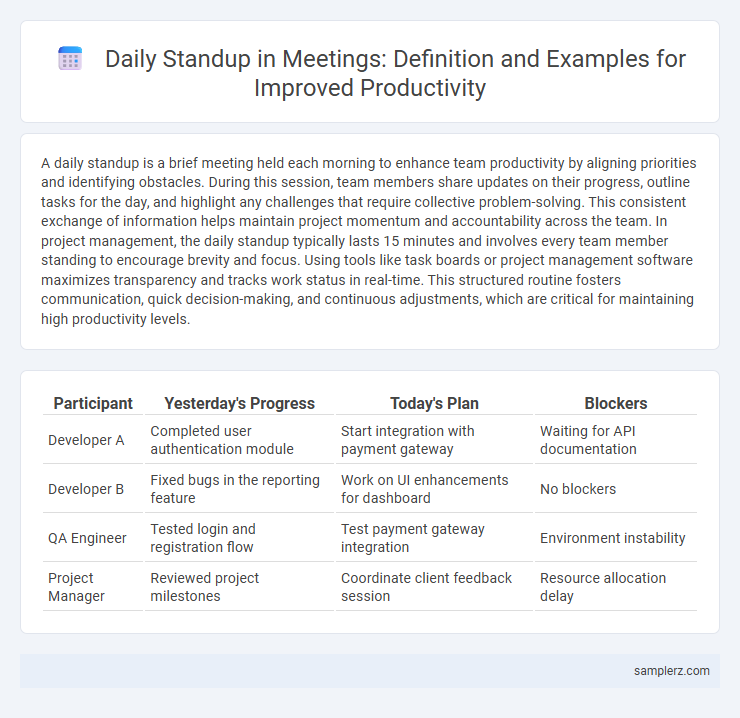A daily standup is a brief meeting held each morning to enhance team productivity by aligning priorities and identifying obstacles. During this session, team members share updates on their progress, outline tasks for the day, and highlight any challenges that require collective problem-solving. This consistent exchange of information helps maintain project momentum and accountability across the team. In project management, the daily standup typically lasts 15 minutes and involves every team member standing to encourage brevity and focus. Using tools like task boards or project management software maximizes transparency and tracks work status in real-time. This structured routine fosters communication, quick decision-making, and continuous adjustments, which are critical for maintaining high productivity levels.
Table of Comparison
| Participant | Yesterday's Progress | Today's Plan | Blockers |
|---|---|---|---|
| Developer A | Completed user authentication module | Start integration with payment gateway | Waiting for API documentation |
| Developer B | Fixed bugs in the reporting feature | Work on UI enhancements for dashboard | No blockers |
| QA Engineer | Tested login and registration flow | Test payment gateway integration | Environment instability |
| Project Manager | Reviewed project milestones | Coordinate client feedback session | Resource allocation delay |
What Is a Daily Standup Meeting?
A daily standup meeting is a brief, time-boxed gathering where team members quickly discuss their progress, planned tasks, and obstacles to enhance productivity and collaboration. Typically held standing to keep it concise, this meeting lasts about 15 minutes and ensures alignment on project goals. Key elements include each participant sharing updates on what they accomplished yesterday, what they plan to do today, and any impediments they face.
Purpose and Benefits of Daily Standups
Daily standups enhance team productivity by fostering real-time communication and transparency, enabling members to quickly share progress, identify roadblocks, and align priorities. Their brief, focused format reduces meeting fatigue and keeps the entire team accountable for daily goals. Consistent standups accelerate problem-solving and improve overall project efficiency through regular, concise status updates.
Structure of an Effective Daily Standup
An effective daily standup meeting follows a concise structure focusing on three key questions: What did you accomplish yesterday? What will you work on today? Are there any blockers impeding your progress? Keeping the meeting time-boxed to 15 minutes enhances team productivity and ensures clear communication.
Sample Daily Standup Agenda
A sample daily standup agenda typically includes a brief update from each team member on what they completed yesterday, what they plan to work on today, and any blockers they are facing. This structured approach helps maintain team alignment, identifies obstacles early, and enhances overall productivity. Keeping the meeting within a strict 15-minute timeframe ensures efficiency and minimizes disruptions to the workday.
Common Questions Asked in Daily Standups
Daily standups typically revolve around three common questions: What did you accomplish yesterday? What are you working on today? Are there any blockers preventing progress? Addressing these questions helps teams maintain alignment, identify obstacles early, and enhance overall productivity through clear communication. Frequent use of digital tools like Jira or Trello can streamline reporting and tracking during these meetings.
Example Script: A Team’s Daily Standup
A team's daily standup typically lasts 15 minutes and follows a structured script where each member answers three key questions: what they accomplished yesterday, what they plan to do today, and any obstacles blocking their progress. This focused format enhances accountability, streamlines communication, and quickly identifies issues affecting productivity. Consistently using this script promotes synchronization and keeps projects on track.
Challenges and Solutions in Daily Standup Meetings
Daily standup meetings prioritize clear communication of challenges such as task bottlenecks or resource constraints, enabling the team to collaboratively identify and implement solutions like adjusted workflows or timely support. Highlighting impediments early ensures quick resolution and sustained productivity. This focused approach enhances transparency and accelerates problem-solving within agile teams.
Tips to Keep Daily Standups Productive
Daily standups remain productive by limiting each participant's update to 1-2 minutes, focusing strictly on key progress, blockers, and immediate goals. Using a time-boxed format encourages concise communication and prevents meetings from running over schedule. Visual aids like task boards or progress charts help maintain clarity and alignment among team members during the standup.
Standup Meeting Etiquette: Do’s and Don’ts
Daily standup meetings should start promptly, with each team member briefly sharing progress, plans, and obstacles within a strict time limit of 15 minutes to maintain productivity. Do maintain focus by avoiding off-topic discussions and using concise language to respect everyone's time. Don't interrupt speakers, monopolize the conversation, or dive into problem-solving during the standup; these behaviors disrupt the meeting flow and reduce overall team efficiency.
Tools for Facilitating Daily Standup Meetings
Using tools like Jira, Trello, or Microsoft Teams streamlines daily standup meetings by providing real-time task updates and visual project tracking. Video conferencing platforms such as Zoom or Slack enhance communication for remote teams, ensuring seamless interaction and accountability. Collaborative features like timers and automated reminders help maintain meeting efficiency and focus on key objectives.

example of daily-standup in meeting Infographic
 samplerz.com
samplerz.com